Equip field reps with precision, speed, and compliance.
Remote sales teams face mounting pressure to deliver results without the benefit of centralized oversight and collaboration. Inconsistent quoting processes, delayed deal approvals, and fragmented visibility into pipeline performance create significant revenue leaks for distributed organizations. Configure-Price-Quote (CPQ) technology emerges as the strategic solution, enabling field teams to maintain enterprise-level accuracy and speed while operating autonomously. This comprehensive guide explores how revenue leaders can leverage CPQ systems to transform distributed sales operations, reduce quote-to-cash cycles, and scale field teams profitably.
Ready to transform your distributed sales operations? Schedule a demo with MobileForce to see how CPQ can accelerate your field revenue performance.
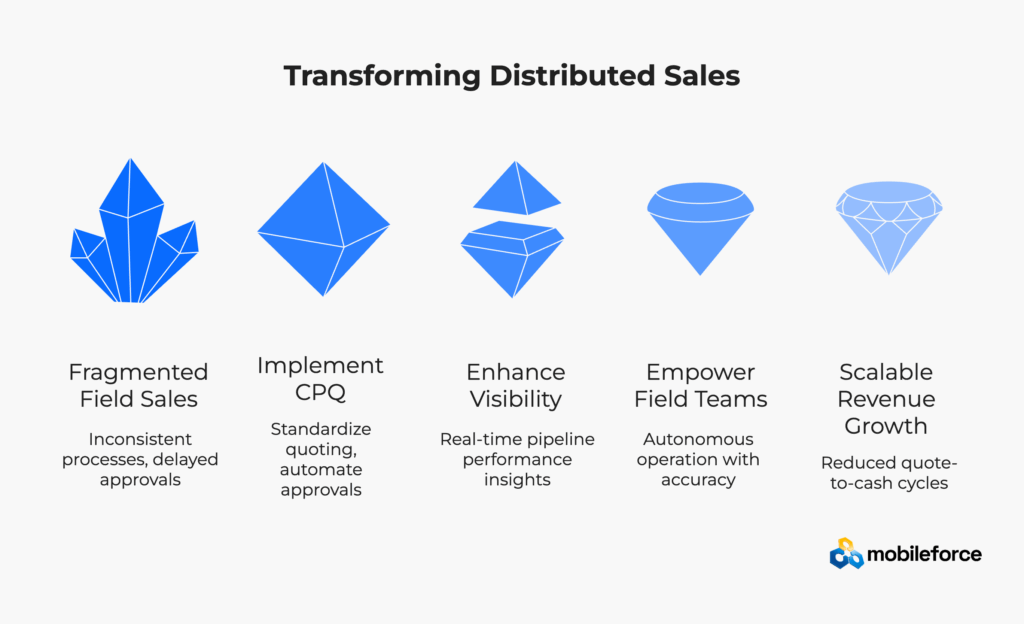
“Sixty percent of sales reps say they spend more time on administrative tasks than actually selling.” This sobering statistic from Salesforce reveals a truth that hits distributed teams particularly hard. When your top field rep spends three hours crafting a complex quote for a Fortune 500 prospect, only to have finance flag a 15% margin error during approval, time becomes your enemy. By the time corrections flow through remote approval chains and re-approvals get secured, competitors have already won the deal.
This scenario repeats thousands of times daily across distributed organizations. According to Salesforce research, sales reps spend only 28% of their time actually selling, with the majority lost to administrative inefficiencies. For remote field teams, these challenges multiply exponentially as geographic barriers compound process friction.
The modern revenue landscape demands speed, accuracy, and scale simultaneously. Distributed sales teams that once thrived on relationship-building and local market knowledge now compete in a digital-first environment where quote turnaround time often determines deal outcomes. Traditional manual processes that worked in centralized offices become liability drains when spread across geographic boundaries.
Configure-Price-Quote (CPQ) technology represents the strategic evolution revenue leaders need to unlock distributed team potential. Rather than viewing remote work as a constraint, forward-thinking CROs are leveraging CPQ systems to create competitive advantages that centralized competitors cannot match.
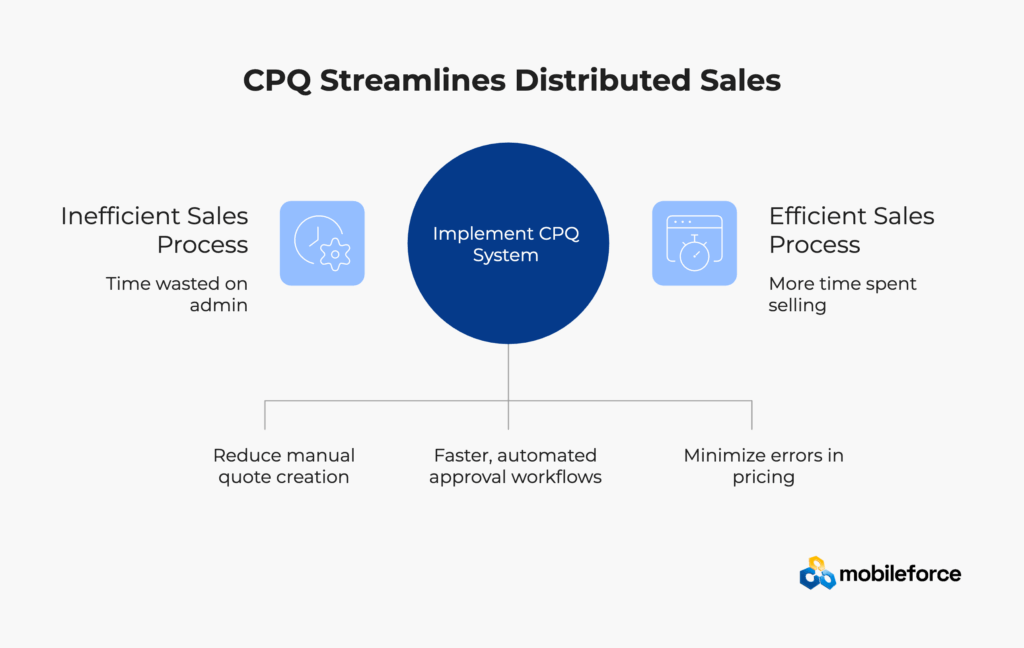
Remote field teams operate without the safety net of immediate managerial oversight or peer review that office-based reps enjoy. A pricing mistake that might be caught in casual conversation now becomes a customer-facing embarrassment or, worse, a margin-eroding commitment.
Research from Aberdeen Group indicates that companies with manual quoting processes experience error rates between 20-40% on complex deals. These errors compound in distributed environments where approval cycles stretch longer and correction opportunities diminish.
Consider the ripple effects: An incorrectly priced quote doesn’t just impact immediate revenue. It sets customer expectations, influences competitive positioning, and potentially violates compliance requirements. For field teams serving multiple territories, a single pricing inconsistency can undermine months of market development work.
Traditional approval workflows assume synchronous communication and shared work schedules. Distributed teams operate across time zones, creating natural delays that competitors can exploit. A quote requiring three levels of approval might take days instead of hours, providing ample opportunity for prospects to engage alternative vendors.
McKinsey research shows that sales cycle length directly correlates with win rates. Each additional day in the quote-to-proposal process reduces close probability by an average of 2.3%. For distributed teams managing dozens of opportunities simultaneously, these delays aggregate into significant revenue impact.
CROs managing distributed teams face an inherent information asymmetry challenge. Field reps control local relationships and deal intelligence, but headquarters needs aggregate visibility for strategic decision-making. Traditional reporting mechanisms create lag time that obscures real-time pipeline health.
Without immediate visibility into quoting activity, pricing trends, and approval bottlenecks, revenue leaders cannot identify problems until they become revenue shortfalls. According to CSO Insights, only 43% of sales organizations accurately forecast within 5% of actual results, with distributed teams showing significantly lower accuracy rates.
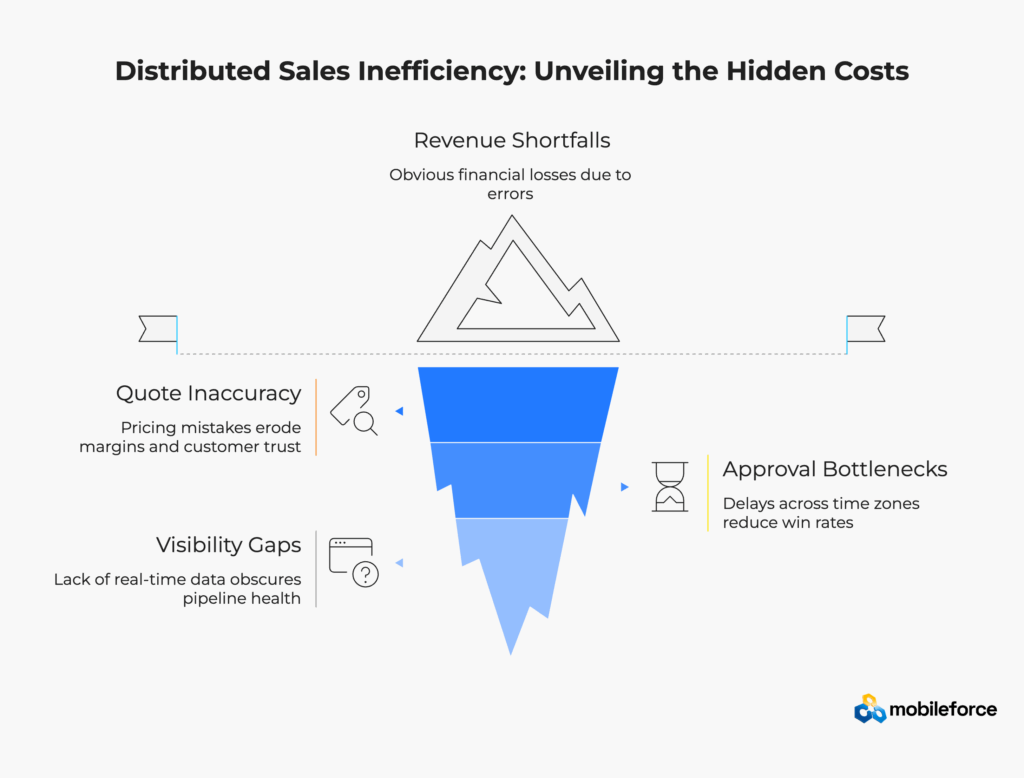
Modern CPQ systems solve the fundamental tension between consistency and flexibility that distributed teams face. Rather than restricting field reps to rigid product catalogs, advanced CPQ platforms provide guided configuration tools that ensure accuracy while enabling customization.
Think of CPQ as providing “guardrails” rather than “roadblocks.” Field reps maintain the flexibility to address unique customer requirements while operating within predetermined parameters that protect margins and compliance standards. This approach preserves the entrepreneurial spirit that makes field teams effective while eliminating the risks that make remote management challenging.
Gartner research indicates that organizations implementing CPQ systems see average quote accuracy improvements of 85% within the first year. For distributed teams, this accuracy gain translates directly into faster approvals and shorter sales cycles.
The most successful CPQ implementations don’t replace human judgment—they amplify it. Automated approval workflows route deals based on predefined criteria, ensuring complex opportunities receive appropriate oversight while enabling routine deals to process immediately.
Consider a scenario where a field rep configures a $50,000 standard solution. The CPQ system can automatically approve pricing within established parameters, generate contract documents, and notify relevant stakeholders—all while the rep remains focused on customer conversation. Meanwhile, a $500,000 custom configuration would automatically route through appropriate approval channels with complete documentation and justification.
This intelligent automation reduces the administrative burden that traditionally constrained field productivity while ensuring high-stakes decisions receive proper oversight. Sales Hacker research shows that sales teams using automated approval workflows reduce quote-to-cash cycles by an average of 45%.
CPQ systems generate unprecedented visibility into distributed sales operations through real-time analytics and reporting. Rather than waiting for end-of-month pipeline reviews, revenue leaders can monitor field performance, identify trends, and address issues as they develop through advanced sales intelligence platforms and predictive analytics tools.
Modern CPQ platforms provide dashboard views that aggregate individual rep activity into organizational intelligence. CROs can identify which products are selling in which territories, track approval bottlenecks by deal size or complexity, and monitor margin trends across the distributed organization using comprehensive revenue analytics and business intelligence systems.
These enterprise-grade reporting capabilities extend beyond basic sales tracking to include advanced metrics like quote conversion rates, pricing optimization insights, competitive win/loss analysis, and territory performance benchmarking that enable data-driven revenue strategy adjustments in real-time.
Interested in seeing how real-time CPQ analytics can transform your revenue visibility? Schedule a demo with MobileForce to explore our customized sales reporting solutions and revenue intelligence platform.
Traditional Process | CPQ-Enabled Process | Improvement |
Manual quote creation: 2-4 hours | Automated configuration: 15-30 minutes | 75-85% time reduction |
Approval cycle: 3-7 days | Intelligent routing: 4-24 hours | 60-80% faster approvals |
Error rate: 20-40% | Guided configuration: 3-5% | 85-95% accuracy improvement |
Forecast accuracy: 43% | Real-time visibility: 78% | 35% better forecasting |

Successful CPQ implementation begins with comprehensive process mapping that captures the unique requirements of distributed operations. Unlike centralized teams where workflows can be observed and optimized organically, remote teams require explicit documentation and standardization.
Start by conducting virtual workflow sessions with field reps from different territories and experience levels. The goal is understanding not just what the official process should be, but how deals actually flow in practice. Often, the most effective field reps have developed informal shortcuts or workarounds that can inform optimal CPQ configuration.
Document approval hierarchies, pricing authorities, and configuration rules with special attention to geographic or vertical market variations. A healthcare territory might require different compliance checks than a manufacturing territory, but both need integration into the same CPQ platform.
According to Forrester research, organizations that invest in comprehensive process mapping before CPQ implementation see 40% higher adoption rates and 25% faster time-to-value compared to those that implement technology first and adjust processes later.
CPQ systems function most effectively when integrated seamlessly with existing revenue technology stacks. For distributed teams, this integration becomes even more critical because field reps cannot rely on manual workarounds or local IT support to bridge system gaps.
Prioritize integrations with your CRM system to ensure lead-to-cash processes flow smoothly. Field reps should be able to configure quotes directly within familiar CRM interfaces rather than switching between multiple platforms. Similarly, ERP integration ensures that approved quotes automatically generate fulfillment workflows without manual handoffs.
Consider mobile capabilities as a primary requirement rather than a nice-to-have feature. Field reps often work from customer sites, home offices, or remote locations where desktop access isn’t practical. Mobile-optimized CPQ platforms enable quote generation and approval processes from any location with internet connectivity.
For more insights on CPQ integration best practices, explore MobileForce’s comprehensive approach to revenue technology unification.
Distributed teams present unique training challenges because traditional classroom-style sessions aren’t practical or effective. Successful CPQ adoption requires creating training programs specifically designed for remote consumption and self-paced learning.
Develop modular training content that field reps can consume during downtime between customer meetings. Interactive video tutorials, simulation environments, and gamified learning modules tend to drive higher engagement than static documentation or webinar formats.
Implement a buddy system that pairs CPQ early adopters with newer users. This peer-to-peer support model works particularly well for distributed teams because it creates natural accountability and provides ongoing support beyond formal training programs.
Ready to accelerate your team’s CPQ adoption and remote sales transformation? Contact MobileForce to explore our proven training methodologies for distributed sales teams and sales enablement programs.
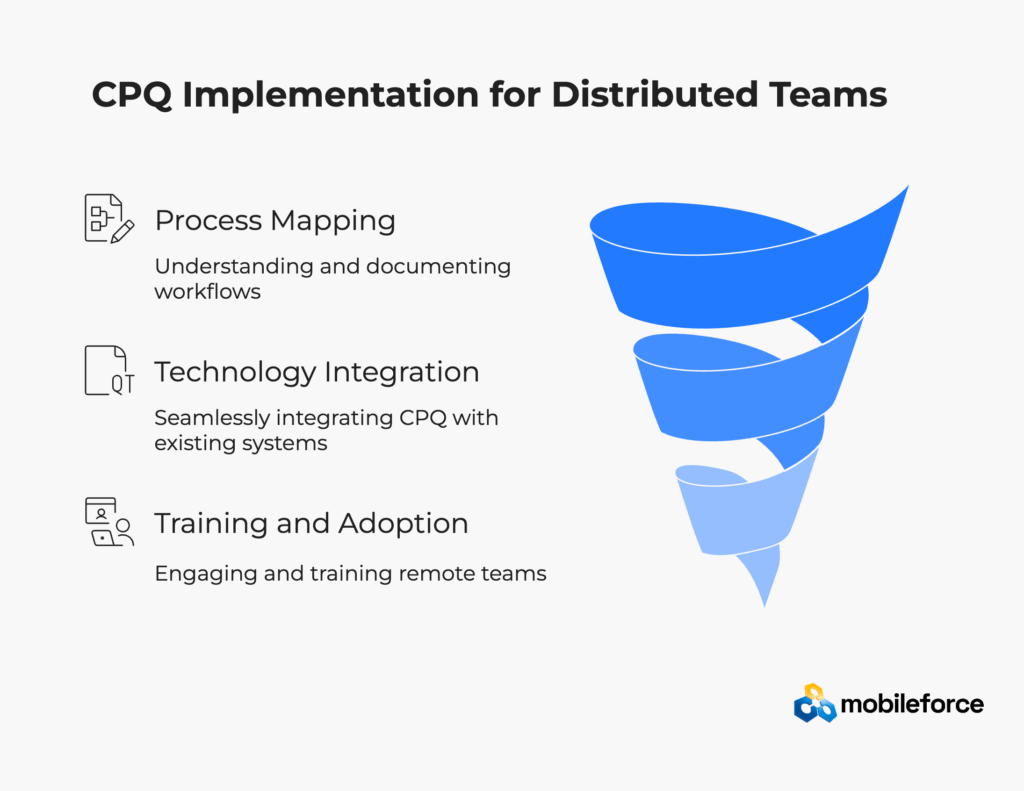
For distributed teams, speed often determines competitive outcomes more than product features or pricing. Prospects working with remote sales reps expect faster responsiveness precisely because they aren’t limited by geographic constraints. CPQ systems should demonstrably improve velocity across multiple touchpoints.
Track quote generation time from initial customer request to delivered proposal. Best-in-class organizations achieve average quote times under 30 minutes for standard configurations and under 4 hours for complex custom solutions. These benchmarks become achievable for distributed teams when CPQ systems eliminate manual configuration and approval bottlenecks.
Monitor approval cycle times by deal size and complexity. Establish baseline measurements before CPQ implementation, then track improvements monthly. Organizations typically see 50-70% reductions in approval cycles within 90 days of CPQ deployment.
Measure time-to-contract from quote delivery to signed agreement. While this metric includes customer decision-making time beyond sales control, shorter sales cycles often indicate improved proposal quality and customer confidence generated by professional, accurate documentation.
Distributed teams must maintain enterprise-level accuracy without centralized oversight. CPQ systems should virtually eliminate common errors while ensuring consistent pricing and configuration across all territories.
Track quote accuracy rates by measuring revisions required after initial delivery. Organizations using manual processes typically see 20-40% of quotes requiring corrections, while CPQ-enabled teams achieve accuracy rates above 95%.
Monitor pricing consistency across territories and rep performance. Calculate coefficient of variation for similar deal types to identify outliers that might indicate training needs or configuration issues.
Measure contract terms standardization to ensure legal and compliance requirements remain consistent across distributed operations. CPQ systems should generate contract language automatically based on configuration choices, eliminating inconsistencies that create downstream fulfillment problems.
Ultimately, CPQ success must translate into measurable revenue improvements for distributed organizations. Focus on metrics that directly correlate with business outcomes rather than just operational efficiency.
Track average deal size improvements as CPQ systems often enable more sophisticated configurations that increase transaction values. Research from Salesforce indicates that organizations using CPQ see average deal sizes increase by 15-25% due to improved upselling and cross-selling capabilities.
Monitor win rates by territory and rep performance. CPQ systems should improve win rates through faster response times, more accurate proposals, and more professional presentation quality. Organizations typically see win rate improvements of 10-20% within six months of CPQ implementation.
Measure revenue per rep productivity to ensure distributed teams achieve scaling benefits from CPQ investment. Calculate monthly recurring revenue generated per field rep, adjusting for territory size and market maturity. CPQ systems should enable individual reps to handle larger territories and more complex deals effectively.
Metric | Pre-CPQ Baseline | Post-CPQ Target | Typical Achievement |
Quote Generation Time | 2-4 hours | 15-30 minutes | 75% improvement |
Quote Accuracy Rate | 60-80% | 95%+ | 85% improvement |
Approval Cycle Time | 3-7 days | 4-24 hours | 70% improvement |
Average Deal Size | Baseline | 15-25% increase | 20% average increase |
Win Rate | Baseline | 10-20% increase | 15% average increase |
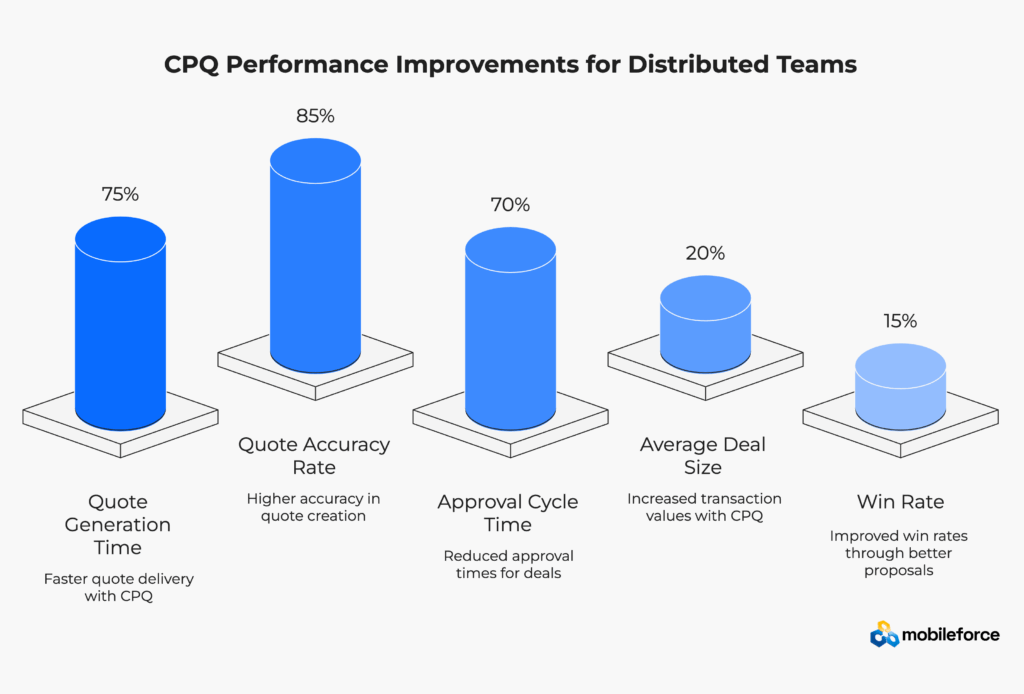
Advanced CPQ systems enable distributed teams to implement sophisticated pricing strategies that would be impossible to manage manually across multiple territories. Rather than relying on static price lists, modern platforms can incorporate real-time market data, competitive intelligence, and customer-specific factors into pricing recommendations.
Consider implementing geographic pricing variations that reflect local market conditions while maintaining corporate margin requirements. A field rep in a high-cost metropolitan market might have different pricing parameters than colleagues serving rural territories, but both operate within the same CPQ framework ensuring consistency and compliance.
Seasonal pricing adjustments, volume-based discounting, and competitive response pricing can all be automated through CPQ rules engines. This automation enables field reps to respond dynamically to market conditions without requiring approval for every pricing decision.
Aberdeen Group research shows that organizations using dynamic pricing through CPQ systems achieve 2-4% higher margins on average compared to those using static pricing models, with distributed teams showing the highest improvement rates due to better local market responsiveness.
Machine learning capabilities within modern CPQ platforms can analyze historical deal patterns to provide configuration recommendations that increase deal size and win probability. For distributed teams, these recommendations become particularly valuable because individual reps may not have visibility into successful patterns from other territories.
Implement recommendation engines that suggest complementary products, service packages, or configuration options based on customer industry, deal size, or historical purchasing patterns. These suggestions help field reps identify upselling opportunities they might otherwise miss while ensuring recommendations align with proven successful combinations.
Use predictive analytics to identify deals at risk based on configuration choices, pricing levels, or approval delays. Early warning systems enable proactive intervention that can save deals before they reach critical stages.
Distributed teams often serve international markets or operate across regulatory boundaries that require specialized handling. Advanced CPQ systems can automatically handle currency conversions, tax calculations, and compliance requirements based on customer location and deal characteristics.
Configure automatic compliance checking for industry-specific requirements such as HIPAA for healthcare customers or SOX compliance for financial services deals. These automated checks ensure field reps don’t inadvertently create compliance violations while enabling them to serve specialized markets effectively.
Implement multi-language document generation so field reps can serve international customers with professionally translated proposals and contracts. This capability extends market reach while maintaining corporate branding and legal compliance standards.
Looking to implement advanced CPQ capabilities for your distributed team? Schedule a consultation with MobileForce to explore predictive configuration and compliance automation features.
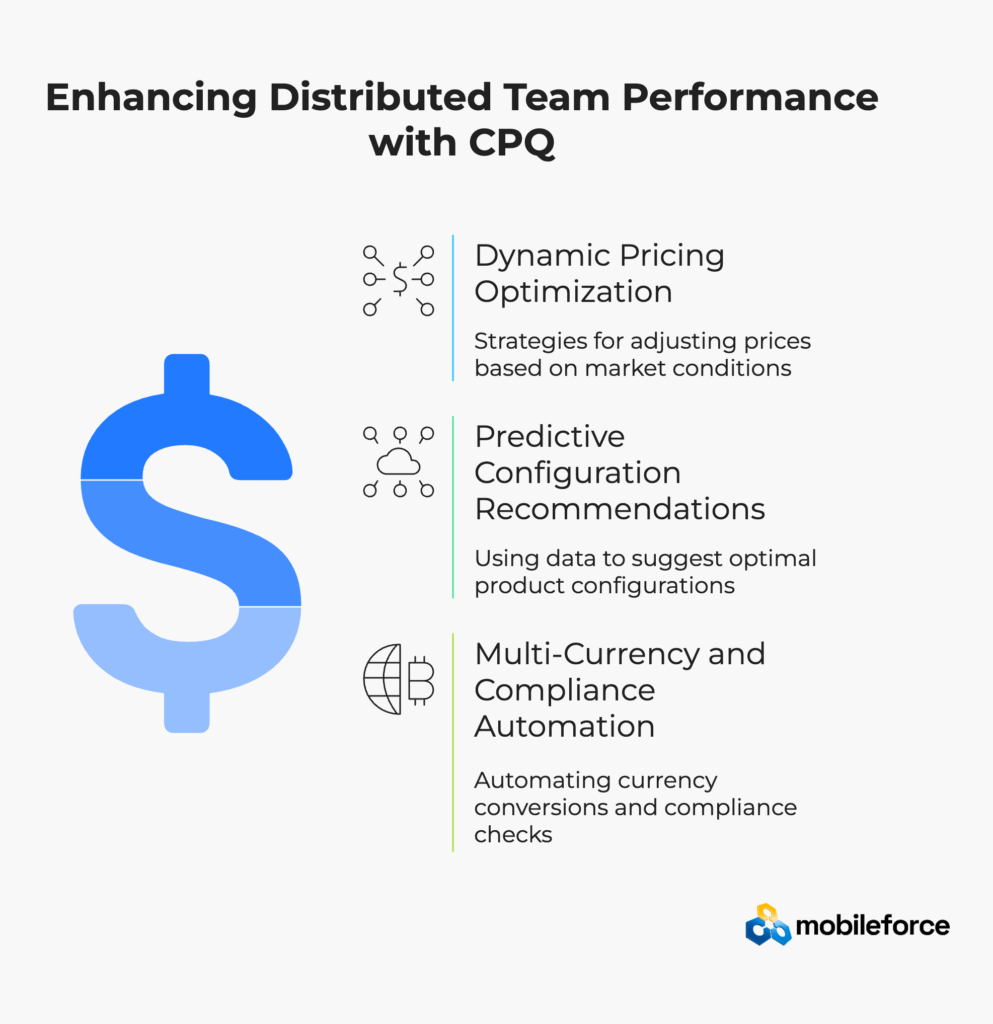
Many organizations approach CPQ implementation by attempting to replicate every possible business scenario and exception within the system configuration. This approach typically leads to overly complex systems that inhibit rather than enable field team productivity.
Instead, implement CPQ using the 80/20 principle: configure the system to handle 80% of standard deals automatically while creating escalation paths for the 20% of complex scenarios that require manual intervention. This approach delivers immediate value while maintaining flexibility for unique situations.
Start with basic product configurations and pricing rules, then add complexity gradually based on user feedback and adoption patterns. Field reps are more likely to embrace systems that simplify their daily work rather than adding additional complexity to their processes.
Distributed teams face unique change management challenges because peer influence and managerial oversight that drive adoption in centralized offices aren’t naturally present. Remote reps may default to familiar manual processes unless CPQ systems provide obvious immediate benefits.
Develop champion programs that identify early adopters within each territory or vertical market. These champions become local advocates who can demonstrate success and provide peer-to-peer support during adoption phases.
Create incentive programs that reward CPQ usage and success metrics rather than simply mandating system adoption. Recognition programs, performance bonuses tied to quote accuracy, or quota relief for adoption periods can accelerate voluntary engagement with new systems.
CPQ systems depend on accurate, consistent data from CRM, ERP, and other enterprise systems for seamless operation and data integrity. Poor data quality or incomplete integrations create user frustration and system abandonment, particularly for field teams who cannot easily access IT support for troubleshooting in remote environments.
Implement data quality auditing before CPQ deployment to identify and correct issues in source systems through data cleansing and validation processes. Clean customer data, accurate product catalogs, and properly configured pricing rules are prerequisites for successful CPQ implementation and system reliability.
Plan integration testing that specifically addresses distributed team workflows including mobile access, offline functionality, and bandwidth limitations that field reps commonly encounter through performance testing and connectivity validation. Remote access requirements and network constraints must be thoroughly tested for field deployment success.
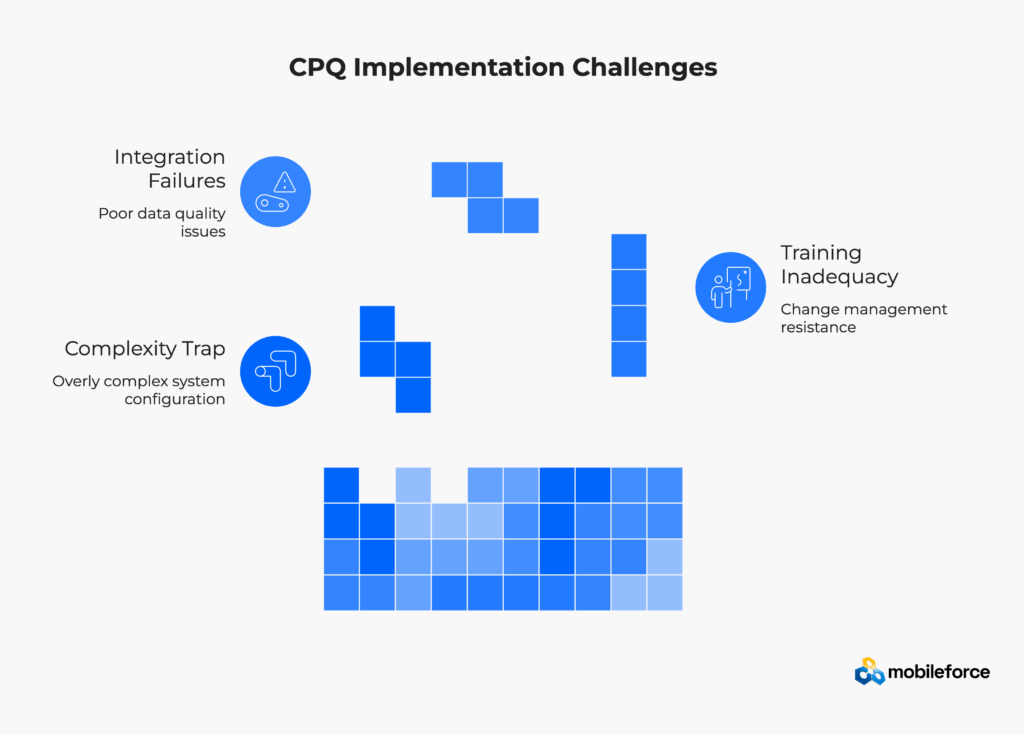
Traditional enterprise software often treats mobile access as an afterthought, creating responsive interfaces that technically function on mobile devices but provide poor user experiences. For distributed teams, mobile capability must be a primary design consideration rather than a secondary feature.
Evaluate CPQ platforms based on native mobile applications rather than browser-based responsive designs. Native applications provide better performance, offline capability, and integration with device features like cameras for document capture or GPS for location-based pricing.
Test mobile functionality under realistic field conditions including limited bandwidth, intermittent connectivity, and various device types. Field reps often work from customer sites with restricted internet access or public Wi-Fi networks that don’t support bandwidth-intensive applications. According to Cisco’s Visual Networking Index, mobile data traffic continues growing at 46% annually, making mobile optimization increasingly critical.
Distributed teams often experience rapid growth that can strain technology platforms not designed for scaling across geographic boundaries. Evaluate CPQ systems based on their ability to handle increased user volumes, transaction loads, and data storage requirements.
Consider geographic distribution of data centers and content delivery networks to ensure consistent performance across territories. A CPQ system that performs well from corporate headquarters may experience latency issues for field reps in remote markets.
Test concurrent user limits and peak load handling to ensure the system can accommodate distributed teams working across time zones. Unlike centralized teams that create predictable usage patterns, distributed teams may generate continuous system load that requires robust infrastructure support.
Modern revenue organizations typically use 10-15 different software tools in their tech stack. CPQ systems must integrate seamlessly with existing tools rather than requiring replacement of functional systems.
Prioritize platforms with robust API ecosystems and pre-built integrations with common CRM, ERP, and marketing automation platforms. Custom integration development is expensive and time-consuming, particularly for distributed teams that need immediate functionality.
Evaluate data synchronization capabilities to ensure information remains consistent across integrated systems. Field reps working with outdated customer information or incorrect pricing data will quickly abandon CPQ systems in favor of manual processes they can control.
For a comprehensive view of how MobileForce integrates with existing tech stacks, explore our no-code configuration approach that simplifies complex implementations.
Need help evaluating CPQ platforms for your distributed team? Contact MobileForce for expert guidance on technology selection and implementation planning.
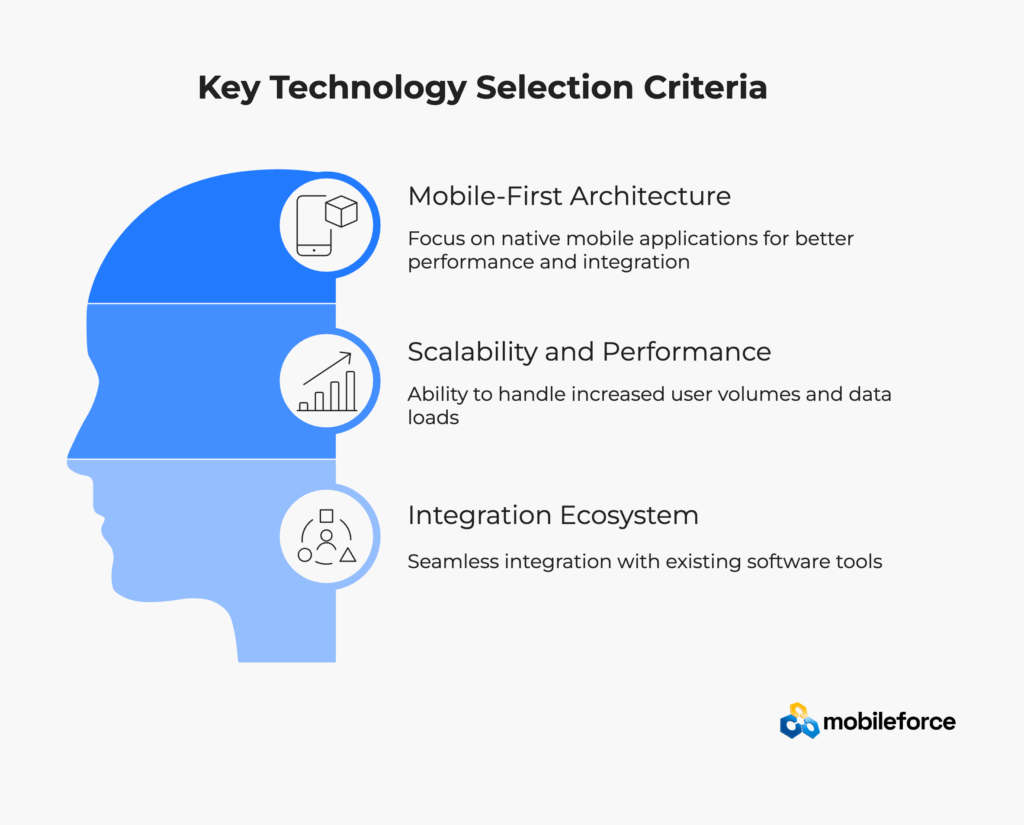
Building compelling business cases for CPQ investment requires accurate measurement of current inefficiencies and their financial impact. Distributed teams often experience hidden costs that aren’t captured in traditional sales metrics.
Calculate the fully loaded cost of quote errors including customer service time, legal review for corrections, delayed revenue recognition, and potential customer churn. A single pricing error that requires contract renegotiation can cost thousands of dollars in internal labor costs alone.
Measure opportunity costs from delayed quotes and extended sales cycles. Use win rate analysis to estimate deals lost due to slow response times compared to competitors who can deliver quotes faster.
Quantify administrative time spent by field reps on non-selling activities including quote preparation, approval coordination, and error correction. This time analysis often reveals that top performers spend 40-50% of their time on activities that CPQ systems can automate.
Develop financial models that account for both direct cost savings and revenue improvements from CPQ implementation. Conservative estimates should focus on measurable efficiency gains while optimistic scenarios can include strategic benefits like market expansion or competitive advantages.
Model implementation costs including software licensing, integration development, training programs, and change management resources. Distributed teams often require higher training investments but achieve faster adoption once initial resistance is overcome.
Calculate payback periods based on conservative adoption curves that account for distributed team challenges. Most organizations achieve positive ROI within 12-18 months, but distributed teams may require 6-12 additional months to reach full adoption and benefit realization.
Project long-term financial benefits including reduced headcount requirements for support functions, improved forecast accuracy, and enhanced ability to scale operations without proportional administrative cost increases.
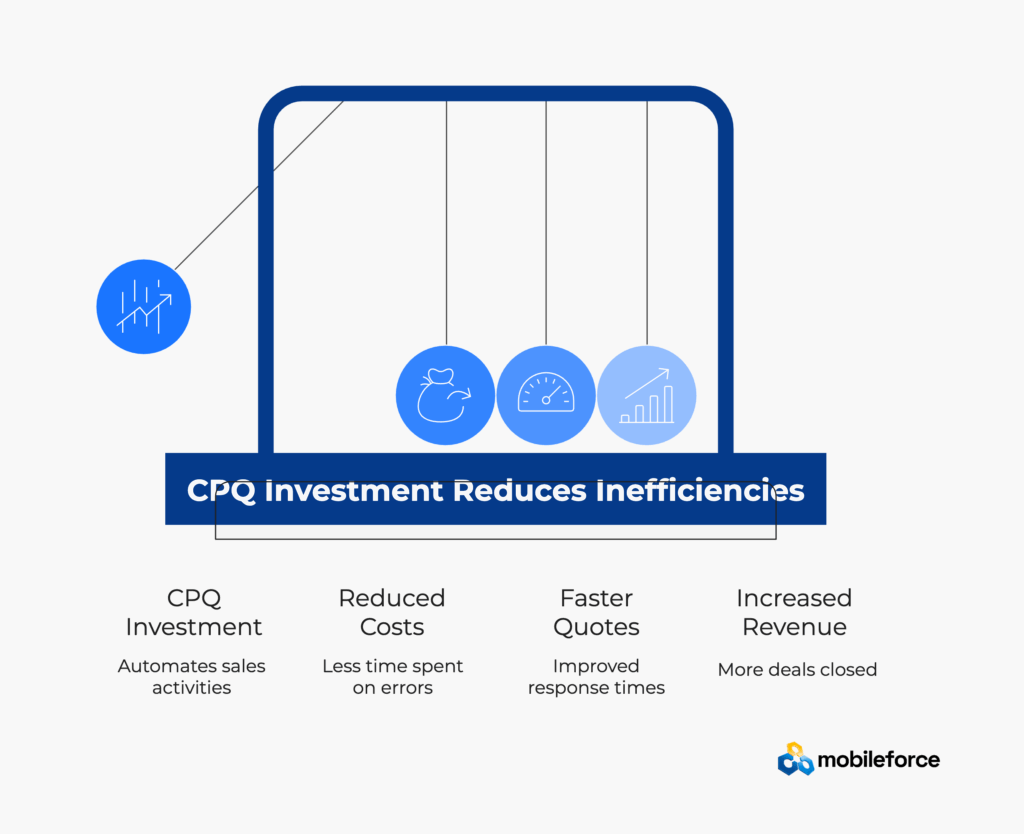
The next generation of CPQ systems will incorporate artificial intelligence capabilities that transform distributed sales operations from reactive to predictive. AI-powered configuration recommendations, dynamic pricing optimization, and predictive deal scoring will enable field reps to compete at levels previously reserved for enterprise sales teams.
Consider how AI capabilities might enhance your distributed team effectiveness. Predictive lead scoring can help field reps prioritize prospects more effectively. Dynamic pricing recommendations can optimize margins while maintaining competitive positioning. Automated configuration suggestions can increase deal sizes and reduce sales cycle lengths.
Evaluate CPQ vendors based on their AI development roadmaps and current capabilities. Early adoption of AI-enhanced features can provide competitive advantages, but ensure underlying platform architecture can support advanced capabilities without requiring complete system replacement.
Revenue technology stacks continue evolving rapidly with new categories like revenue intelligence, conversation analytics, and digital sales rooms becoming standard requirements. CPQ systems must integrate effectively with these emerging technologies to maintain relevance.
Plan for integration with conversation intelligence platforms that can analyze customer calls and automatically suggest configuration adjustments or pricing modifications based on customer feedback and competitive intelligence.
Consider how CPQ systems will interact with digital sales room technologies that provide immersive customer experiences during remote selling processes. Seamless integration between quote generation and digital presentation platforms will become table stakes for distributed teams.
The pandemic accelerated remote work adoption, but distributed selling strategies continue evolving as organizations develop more sophisticated approaches to field team management and customer engagement.
Design CPQ implementations that can adapt to changing work patterns and customer expectations. Flexible architecture that supports both traditional field selling and emerging digital-first approaches will provide long-term value.
Consider how CPQ systems can support hybrid selling models where field reps combine in-person relationship building with digital demonstration and configuration capabilities. The most successful distributed teams will seamlessly blend physical and digital touchpoints throughout the sales process.
Ready to future-proof your distributed revenue operations? Schedule a demo with MobileForce to explore next-generation CPQ capabilities for evolving sales teams.
Transform your distributed sales operations with proven CPQ strategies. Contact MobileForce today to begin your journey toward revenue excellence.
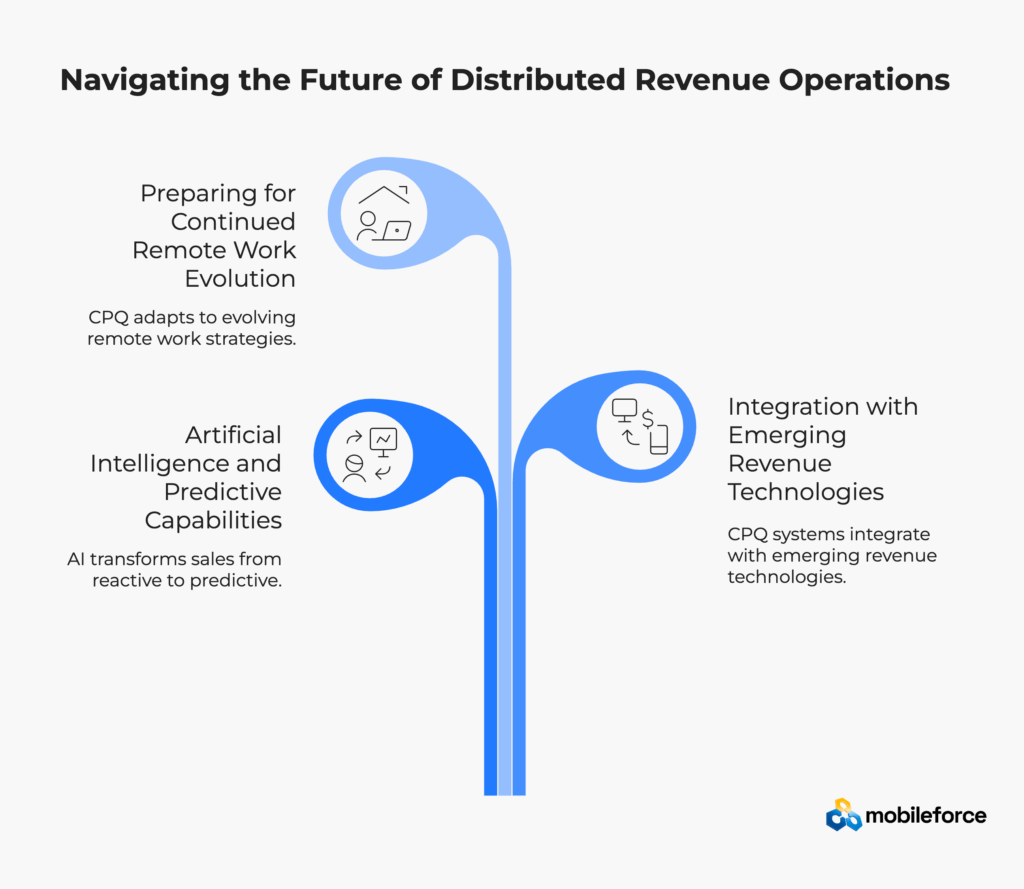
CPQ implementation for distributed teams typically requires 3-6 months, with an additional 3-6 months for full adoption and optimization. The timeline depends on complexity of products and pricing structures, number of integrations required, and geographic distribution of teams. Organizations with simpler product catalogs and existing CRM integrations can achieve faster implementation, while those requiring extensive customization or multiple system integrations may need longer timeframes.
The primary challenges include ensuring reliable mobile functionality across various network conditions, managing training and adoption without in-person support, integrating with existing tech stacks that may have geographic variations, and maintaining consistent approval workflows across time zones. Additionally, data quality issues become more problematic for distributed teams who cannot easily access IT support for troubleshooting.
Modern CPQ systems support territory-based pricing through configurable rule engines that can incorporate geographic factors, local market conditions, competitive landscapes, and currency variations. Administrators can set up pricing matrices that automatically adjust based on customer location, territory assignments, or market segments while maintaining corporate approval requirements and margin protection guidelines.
Advanced CPQ platforms offer offline capability that allows field reps to configure quotes, access product catalogs, and generate proposals without continuous internet connectivity. The system synchronizes data when connectivity is restored, ensuring no work is lost. However, real-time approval workflows and pricing updates require connectivity, so organizations should plan for hybrid online/offline scenarios.
Organizations typically see 15-25% improvements in sales productivity, 20-40% reductions in quote preparation time, 50-70% fewer quote errors, and 10-20% increases in average deal sizes within the first year. ROI calculations should include both direct cost savings from efficiency improvements and revenue gains from faster sales cycles and improved win rates. Most distributed teams achieve positive ROI within 12-18 months.
CRM integration eliminates the need for field reps to switch between multiple systems, reducing errors and improving efficiency. Integrated systems provide complete customer context during quote preparation, automatic opportunity updates when quotes are generated or approved, and seamless handoffs from lead generation through contract execution. For distributed teams, this integration is critical because manual data entry between systems becomes more error-prone without immediate oversight.
Successful training programs for distributed teams emphasize self-paced learning modules, interactive simulations, peer-to-peer mentoring programs, and gamified adoption incentives. Organizations should provide multiple learning formats including video tutorials, written guides, virtual workshops, and one-on-one coaching sessions. Champion programs that identify early adopters as local advocates significantly improve adoption rates across distributed organizations.
CPQ platforms use intelligent routing algorithms that automatically direct quotes through appropriate approval chains based on deal characteristics like size, margin, discount levels, or customer type. Automated workflows ensure approvals happen quickly regardless of approver locations or time zones, while providing complete audit trails and escalation procedures for delayed responses. Mobile approval capabilities enable managers to review and approve deals from any location.
This comprehensive guide provides actionable strategies for implementing CPQ solutions in distributed sales environments. For personalized consultation on your specific distributed team requirements, contact MobileForce’s CPQ experts today.
See how Mobileforce enables distributed teams with compliant, error-free quotes